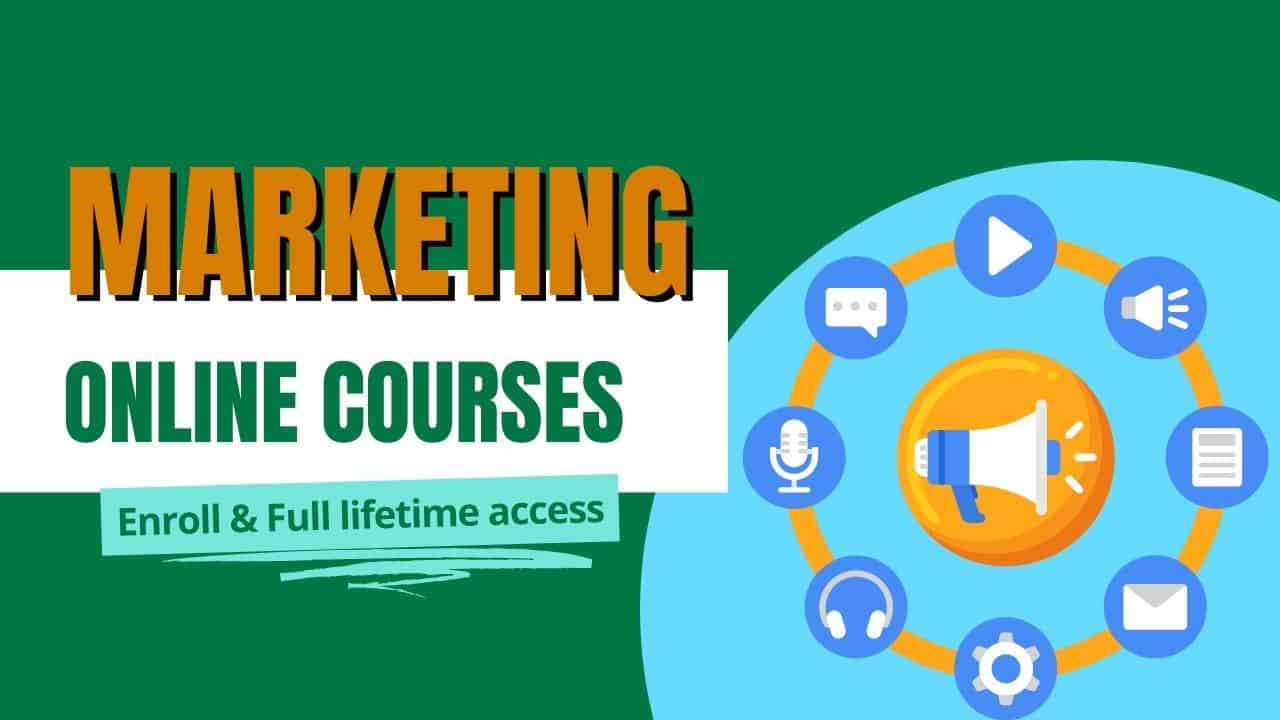Chia sẻ ưu đãi đăng ký truy cập vĩnh viễn một số khóa học MBA online miễn phí.
Khóa học MBA online miễn phí là gì
MBA là viết tắt của “Master of Business Administration” trong tiếng Anh, tức là Thạc sĩ Quản trị Kinh doanh trong tiếng Việt. Một khóa học MBA online là một chương trình học kinh doanh sau đại học mà bạn có thể tham gia trực tuyến từ bất kỳ đâu có kết nối internet.
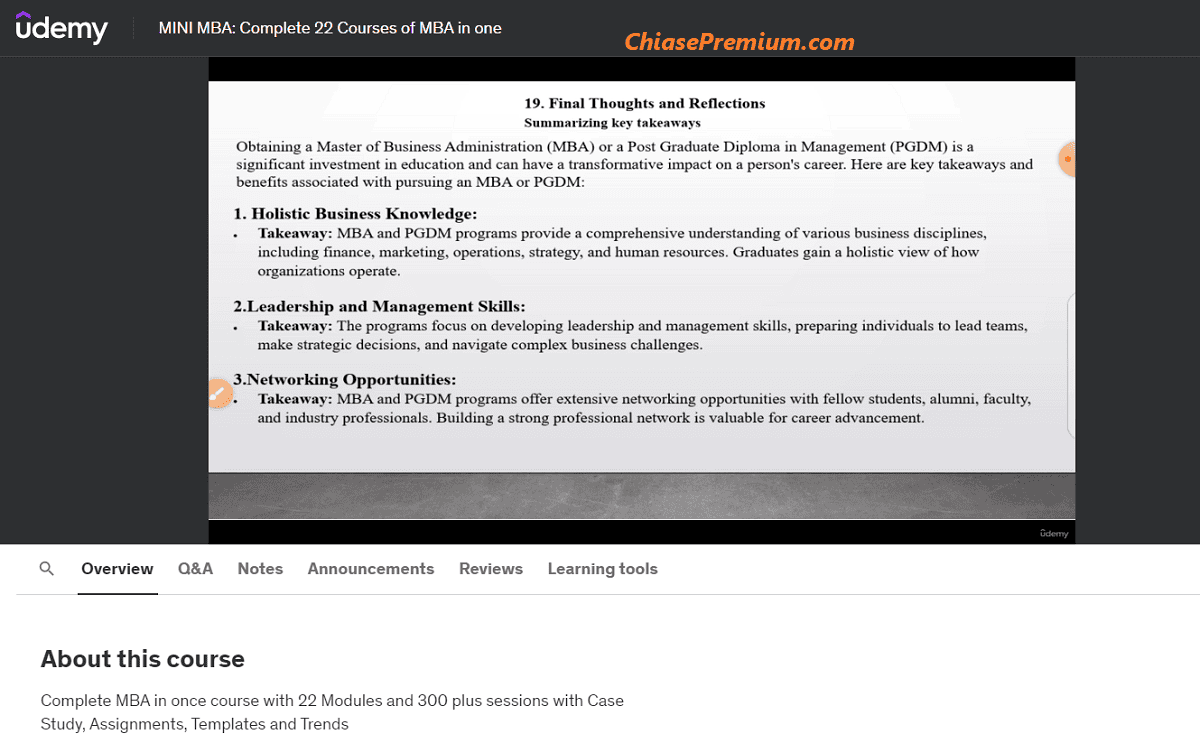
Trong khóa học MBA, bạn sẽ học về nhiều lĩnh vực khác nhau của quản trị kinh doanh, bao gồm tài chính, marketing, quản lý nhân sự, chiến lược kinh doanh, quản lý dự án, và nhiều hơn nữa. Chương trình này thường cung cấp kiến thức sâu rộng và kỹ năng cần thiết để quản lý và điều hành doanh nghiệp hoặc tổ chức một cách hiệu quả.
Để không bỏ lỡ những chia sẻ miễn phí mới nhất, các bạn có theo dõi Facebook Page hoặc đăng ký nhận bản tin chia sẻ premium ở cuối bài viết.
Khóa học MBA online thường linh hoạt hơn so với các chương trình truyền thống, cho phép bạn học tập theo lịch trình riêng của mình, từ xa, và thích ứng với các cam kết công việc và gia đình của bạn. Điều này có thể là lựa chọn lý tưởng cho những người muốn tiếp tục học tập mà không cần phải ngừng công việc hoặc di chuyển đến các trường đại học truyền thống.
Có nhiều trường đại học và tổ chức giáo dục cung cấp các khóa học MBA trực tuyến miễn phí. Một số nền tảng phổ biến cung cấp các khóa học này bao gồm:
- Coursera: Coursera cung cấp một loạt các khóa học MBA từ các trường đại học hàng đầu trên thế giới như Wharton School, University of Illinois, và University of Virginia.
- edX: edX cũng có nhiều khóa học MBA từ các trường như MIT và University of California, Berkeley.
- FutureLearn: FutureLearn cung cấp các khóa học từ các trường và tổ chức giáo dục ở Anh và trên toàn thế giới.
- Khan Academy: Mặc dù không phải là một nền tảng chuyên về kinh doanh, Khan Academy cung cấp một số khóa học về quản trị kinh doanh và kỹ năng liên quan.
- MOOCs (Massive Open Online Courses): Ngoài ra, có nhiều tổ chức khác cung cấp các khóa học MBA miễn phí thông qua các nền tảng MOOCs.
Xem thêm: MBA Course: Marketing and Business Strategy | Free
Hướng dẫn tham gia khóa học MBA online miễn phí
Các bước để tham gia một khóa học MBA online miễn phí:
- Lựa chọn khóa học phù hợp: Trước tiên, bạn cần tìm hiểu và chọn khóa học MBA trực tuyến miễn phí mà phù hợp với nhu cầu học tập và mục tiêu sự nghiệp của bạn. Đảm bảo kiểm tra chương trình học, cấu trúc khóa học, và phương pháp giảng dạy để đảm bảo rằng nó phù hợp với mong muốn và mục tiêu của bạn.
- Tạo tài khoản và đăng ký: Sau khi chọn được khóa học phù hợp, bạn cần tạo một tài khoản trên nền tảng học trực tuyến cung cấp khóa học này. Thông thường, quá trình này đòi hỏi bạn cung cấp thông tin cá nhân cơ bản và đăng ký cho khóa học.
- Hoàn thành các bài học và bài tập: Khi bạn đã đăng ký thành công, bạn có thể bắt đầu học. Hoàn thành các bài học, bài tập, và tham gia vào các hoạt động học tập được yêu cầu trong khóa học. Hãy chắc chắn rằng bạn tuân thủ lịch trình học tập và hoàn thành các nhiệm vụ đúng hạn.
- Tham gia thảo luận và tương tác: Một phần quan trọng của việc học trực tuyến là tham gia vào các hoạt động thảo luận và tương tác với giảng viên và các bạn học viên khác. Thảo luận này giúp bạn học hỏi từ quan điểm và kinh nghiệm của người khác, mở rộng kiến thức và suy nghĩ của mình.
- Nhận chứng chỉ hoàn thành: Cuối cùng, sau khi hoàn thành khóa học, bạn có thể nhận được chứng chỉ hoàn thành từ tổ chức cung cấp khóa học. Tùy thuộc vào chính sách của trường hoặc tổ chức, có thể có một số yêu cầu bổ sung để đạt được chứng chỉ này.
Lưu ý khi tham gia khóa học MBA online miễn phí
Những lưu ý này rất quan trọng khi tham gia khóa học MBA online miễn phí:
- Lựa chọn nguồn cung cấp uy tín: Đảm bảo rằng bạn chọn một tổ chức, trường hoặc nền tảng có uy tín trong việc cung cấp khóa học MBA. Điều này đảm bảo rằng bạn nhận được nội dung chất lượng và được công nhận.
- Cam kết thời gian và nỗ lực: Mặc dù là khóa học miễn phí, nhưng việc học MBA vẫn đòi hỏi sự cam kết cao và nỗ lực đáng kể từ bạn. Đặt ra một kế hoạch học tập cụ thể và tuân thủ nó.
- Tự giác học tập: Khóa học MBA online thường tự học nhiều. Bạn cần tự chủ động trong việc tìm hiểu, nghiên cứu và áp dụng kiến thức vào thực tế. Đừng phụ thuộc quá nhiều vào giảng viên.
- Kết hợp học online và offline: Để có kiến thức toàn diện và trải nghiệm học tập đa dạng, hãy cân nhắc kết hợp học online với việc tham gia các sự kiện offline, nhóm thảo luận hoặc tương tác trực tiếp với người học khác.
Chia sẻ khóa học MBA trực tuyến miễn phí
Trong thời đại số hóa hiện nay, việc tiếp cận kiến thức và cơ hội học tập chưa bao giờ dễ dàng như vậy. Và giữa những thách thức và cơ hội đó, có một nguồn tài nguyên mà mọi người đang khám phá với sự phấn khích: khóa học MBA trực tuyến miễn phí.
Khóa học MBA, với tất cả những kiến thức sâu rộng về quản trị kinh doanh, chiến lược, tài chính, và quản lý nhân sự, trước đây thường được coi là đắt đỏ và khó tiếp cận. Nhưng với sự phát triển của công nghệ và sự xuất hiện của các nền tảng giáo dục trực tuyến, mọi người từ mọi nơi trên thế giới có thể tiếp cận những kiến thức này một cách miễn phí.
Trong bài viết này, chúng ta sẽ khám phá những cơ hội và lợi ích mà các khóa học MBA trực tuyến miễn phí mang lại. Từ việc lựa chọn nguồn cung cấp đến cách tận dụng hiệu quả những tài nguyên này, chúng ta sẽ đi sâu vào thế giới học tập mới mẻ này và tìm hiểu cách mọi người có thể sử dụng chúng để định hình tương lai sự nghiệp và thành công cá nhân của mình.
MINI MBA Complete 22 Courses of MBA in one
Complete MBA in once course with 22 Modules and 300 plus sessions with Case Study, Assignments, Templates and Trends. source: Udemy.com

- 55.5 hours
- 12 articles
- 21 downloadable resources
“What you’ll learn
- You will learn about the introduction to business management and also you will be able to understand about business environment, historical evolution of busin
- You will be able to learn about strategic management related to strategic planning, details about SWOT analysis and different types of business models.
- Learn Leadership and Management related to different types of the leadership styles and management theories including team building and motivation also.
- You will also learn about Marketing and branding relating to marketing principles, market research and also about product development and it’s branding
- You will be able to learn about finance and accounting related to financial statements and its key concepts, budgeting and forecasting.
- Learn Operations Management including supply chain management, process improvement, quality management, project management.
- Human Resources Management related to Recruitment and Selection related to employee development, performance Management and its details including employment law
- Entrepreneurship and Innovation and its startup essentials, innovation and creativity.
- Learn about business ethics and social responsibilities, related to ethical decision making and its details including steps and challenges
- Learn details about corporate social responsibilities, it’s benefits and challenges and many more details related to business ethics and social responsibility.
- Communication and negotiation including negotiation strategies and conflict negotiation.
- Business law and regulations including different types of contract law, contact formation and interpretations, intellectual property and regulatory compliance.
- Learn International business related to globalization, international marketing, cross cultural management.
- Learn about financial management related to investment and capital budgeting, different types of financial markets and its functions.
- You will also be able to learn about different types of financial risks and management
- Entrepreneurial finance related to different types of funding sources, financial planning for startups, venture capital and angel investors.
- Study about different types of case study starting from Introduction of business and management till the case studies and its practical applications.
- This training will be useful for creating a comprehensive capstone project for a Mini MBA program involves integrating knowledge and skills.
- You will also learn about Business Trends and Emerging Technologies related to Exploration of current and future business trends.
- Personal and Professional Development related to Time Management. Strategies for Effective Leadership Development; Networking and Career Advancement.
- Discover how to get the knowledge of Examining Business Failures and Successes related to Analyzing case studies of both successful and failed businesses”
source: Udemy.com
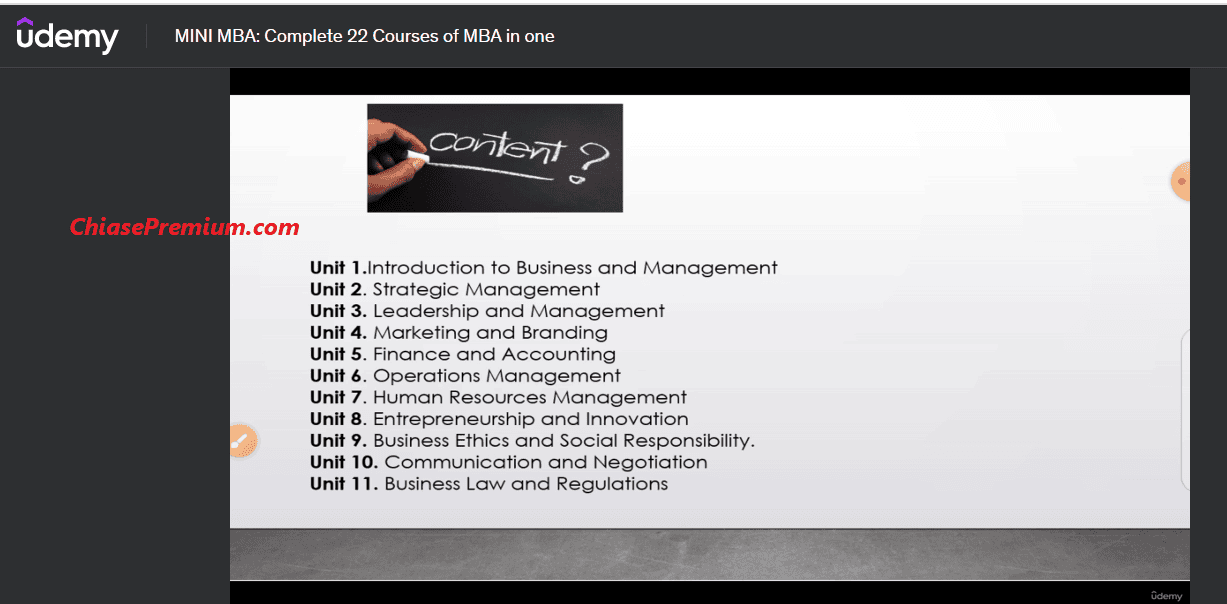
Link đăng ký miễn phí truy cập vĩnh viễn chỉ dành cho 120 đăng ký đầu tiên trong hôm nay (free only for 120 enrolls today) ngày 13.5.2024: https://www.udemy.com/course/mini-mba-complete-22-courses-of-mba-in-one/?couponCode=AD96181B23BE0ECBE29B
Master in Business Administration (MBA)
One of best online MBA courses that teaches what they don’t at top best MBA colleges. All MBA subjects incl. finance. source: Udemy.com
(Note: Pre-MBA for undergraduates course)
“Pre-MBA for undergraduates” là một chương trình hoặc chuỗi các khóa học được thiết kế để chuẩn bị sinh viên đại học cho việc tham gia vào chương trình Thạc sĩ Quản trị Kinh doanh (MBA). Chương trình này có thể bao gồm các khóa học trong các lĩnh vực như kinh doanh, tài chính, quản lý, marketing, và kỹ năng mềm, nhằm cung cấp kiến thức và kỹ năng cần thiết để thành công trong các chương trình MBA. Mục tiêu của pre-MBA cho sinh viên đại học là giúp họ có một sự hiểu biết sâu sắc hơn về các nguyên lý quản trị kinh doanh và chuẩn bị cho những yêu cầu và áp lực của một chương trình MBA
Thông tin khóa học:
- 9.5 hours
- 64 downloadable resources
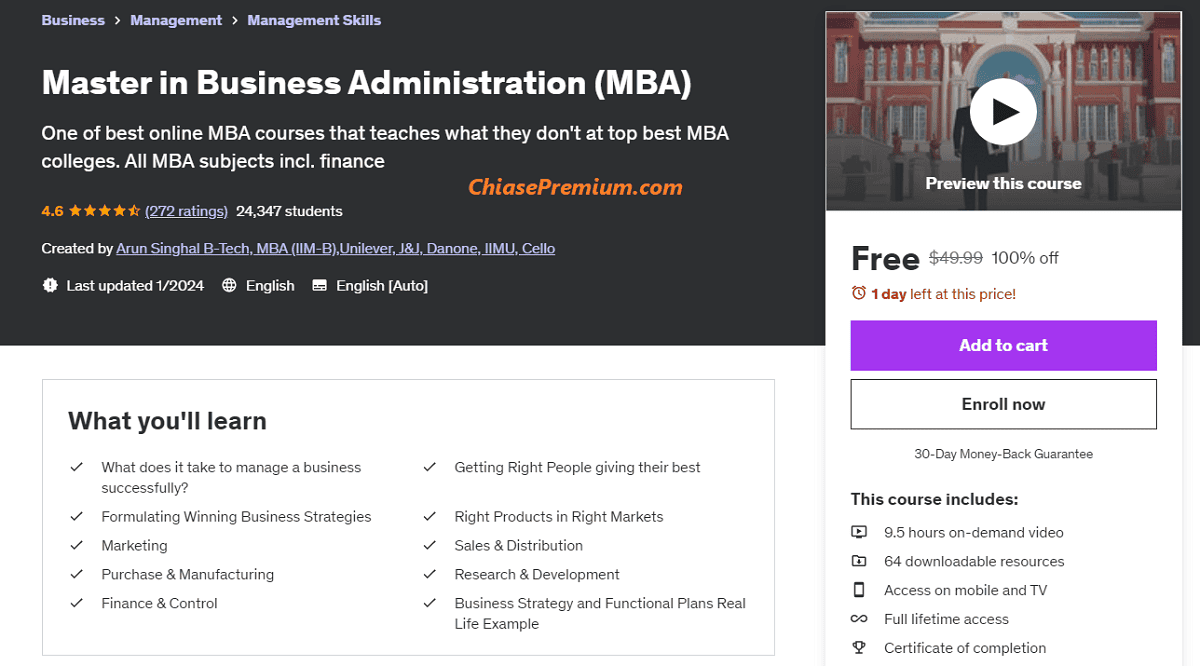
“What you’ll learn
- What does it take to manage a business successfully?
- Getting Right People giving their best
- Formulating Winning Business Strategies
- Right Products in Right Markets
- Marketing
- Sales & Distribution
- Purchase & Manufacturing
- Research & Development
- Finance & Control
- Business Strategy and Functional Plans Real Life Example” source: Udemy.com
“This course provides you a solution to this issue by teaching you about all these management functions integrated by the Business Strategy based on the real life practices
What I am sharing with you here is my learnings over these 40+ years being in business management after doing my MBA from Indian Institute of Management, Bangalore in 1981, pausing my corporate career after becoming Managing Director with erstwhile Danone Nutrition in 2007 and starting to teach and coach people like you do well in life…” source: Udemy.com
Ưu đãi miễn phí truy cập vĩnh viễn chỉ dành cho 120 đăng ký đầu tiên trong hôm nay (free only for 120 enrolls today) ngày 14.5.2024: https://www.udemy.com/course/pre-mba-for-undergraduates/?couponCode=529D1E5C6B28BE46E117
Mini MBA in Technology Management
Mini MBA in Technology Management and Digital Transformation by MTF Institute. source: Udemy.com

What you’ll learn
- Module I: General Management
- Module II. Leadership
- Module III. Product Management
- Module IV. Agile, Project Management and Flexible Management Frameworks
- Module V. Digital Transformation and Role of Chief Digital Officer
- Module VI. Technology Management
- Digital Transformation
- Technology Management
- in-House vs Outsource vs Out-staff work
- Vendors and Contractors Management
- Platform vs Product vs Tech-oriented teams
- Lean 6 Sigma at Technology Management
Course Modules:
Module I: General Management
Module II. Leadership
Module III. Product Management
Module IV. Agile, Project Management and Flexible Management Frameworks
Module V. Digital Transformation and Role of Chief Digital Officer
Module VI. Technology Management
Ưu đãi miễn phí truy cập vĩnh viễn chỉ dành cho 120 đăng ký đầu tiên trong hôm nay (free only for 120 enrolls today) ngày 28.5.2024: https://www.udemy.com/course/mini-mba-in-technology-management-for-cio-cto/?couponCode=640D90EA7217BD7DA306
Mini MBA in Entrepreneurship
Mini MBA by MTF Institute, Major: Entrepreneurship & Innovations + Management, Leadership, Marketing, Finance, Strategy. source: Udemy.com
- 10,5 giờ video theo yêu cầu
- 50 tài nguyên có thể tải xuống
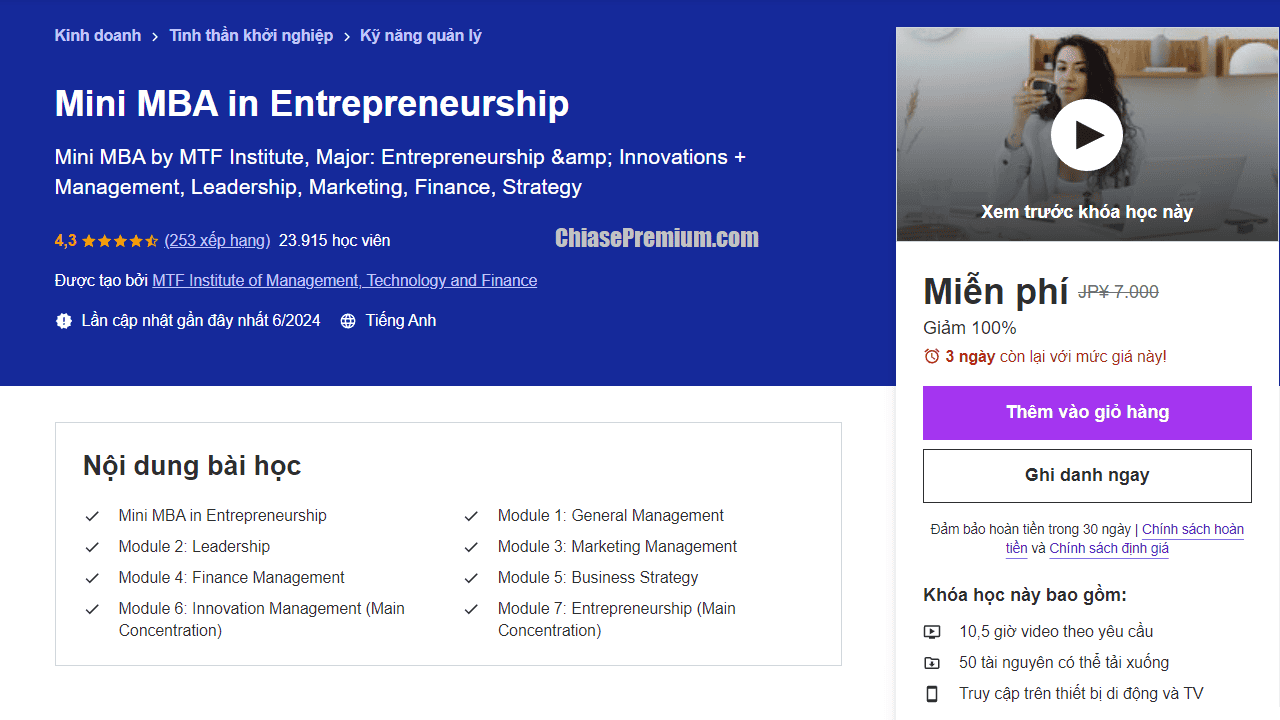
What you’ll learn
- Mini MBA in Entrepreneurship
- Module 1: General Management
- Module 2: Leadership
- Module 3: Marketing Management
- Module 4: Finance Management
- Module 5: Business Strategy
- Module 6: Innovation Management (Main Concentration)
- Module 7: Entrepreneurship (Main Concentration)
Ưu đãi miễn phí truy cập vĩnh viễn chỉ dành cho 120 đăng ký đầu tiên trong hôm nay (free only for 120 enrolls today) cập nhật ngày 05.7.2024:
MBA Programs in Food and Beverage
Ultimate F&B Underground MBA Success Course
Entrepreneurship, Business Strategy, Marketing, Food and Beverage Focused. source: Udemy.com

Khóa học MBA F&B “Ultimate F&B Underground MBA Success Course” mang lại nhiều lợi ích như sau:
- Chiến lược kinh doanh và marketing: Khóa học tập trung vào các chiến lược kinh doanh và marketing, điều mà nhiều doanh nghiệp F&B thường bỏ qua. Đây là yếu tố quan trọng để thu hút khách hàng, xây dựng thương hiệu nổi bật và tăng trưởng lợi nhuận.
- Phát triển thương hiệu: Bạn sẽ học cách làm cho doanh nghiệp F&B của mình trở thành điểm đến được nhiều người biết đến và yêu thích, giúp thu hút khách hàng đều đặn mỗi ngày.
- Chiến lược thực tiễn và hiệu quả: Khóa học cung cấp các chiến lược và chiến thuật thực tế đã được thử nghiệm và chứng minh bởi Gwern Khoo, một doanh nhân F&B thành công với nhiều doanh nghiệp tại Singapore, Hong Kong, Trung Quốc và Úc.
- Lợi thế cạnh tranh: Bạn sẽ khám phá những lợi thế không công bằng mà thậm chí các nhà tư vấn và đại lý không biết, giúp thúc đẩy doanh nghiệp của bạn và tăng lợi nhuận một cách đáng kể.
- Hướng dẫn chi tiết: Khóa học không chỉ dừng lại ở lý thuyết mà còn cung cấp một bản kế hoạch chi tiết, đã được thử nghiệm, giúp bạn biết chính xác các bước cần thực hiện để nâng cao doanh nghiệp F&B của mình.
- Dành cho nhiều đối tượng: Khóa học phù hợp với chủ doanh nghiệp F&B, giám đốc, quản lý nhà hàng/quán cà phê, những người muốn khởi nghiệp trong ngành F&B, đầu bếp và các doanh nghiệp bán lẻ.
Ưu đãi miễn phí đăng ký truy cập vĩnh viễn chỉ dành cho 120 đăng ký đầu tiên trong hôm nay (free only for 120 enrolls today) trong ngày 24.7.2024:
Khóa học MBA Quản lý sản phẩm
MBA in Product Management : Become a Product Manager
Most complete course on Product Management with 13+ hours of videos, assignments, workbook, case studie… source: Udemy.com

Khóa học MBA quản lý sản phẩm mang lại nhiều lợi ích, bao gồm việc cung cấp kiến thức chuyên sâu về quản lý và phát triển sản phẩm, giúp học viên hiểu rõ về quy trình từ ý tưởng đến thị trường. Khóa học còn nâng cao kỹ năng phân tích thị trường, xây dựng chiến lược kinh doanh và quản lý dự án, từ đó tăng khả năng lãnh đạo và ra quyết định hiệu quả. Ngoài ra, học viên còn được mở rộng mạng lưới quan hệ trong ngành, học hỏi từ những chuyên gia giàu kinh nghiệm và tiếp cận những xu hướng mới nhất trong lĩnh vực quản lý sản phẩm, giúp họ tự tin và sẵn sàng đối mặt với các thách thức trong công việc.
Link đ.ký miễn phí truy cập vĩnh viễn chỉ dành cho 120 đăng ký đầu tiên trong hôm nay (Free for the first 120 enrollments today), ngày 5.8.2024:
Các khóa học MBA online miễn phí khác
Một số khóa học MBA online miễn phí truy cập nhưng để lấy chứng chỉ bạn sẽ cần trả phí.
Thông tin chi tiết hơn về mỗi khóa học MBA miễn phí trực tuyến từ các nền tảng khác nhau:
- Coursera – The Fundamentals of Project Management:
- Từ trường: University of Virginia Darden School of Business
- Mô tả: Khóa học này cung cấp một cái nhìn tổng quan về quản lý dự án, từ việc xác định mục tiêu và phạm vi của dự án đến việc triển khai và kiểm tra. Nó cung cấp kiến thức và kỹ năng cần thiết để quản lý dự án hiệu quả.
- Thời lượng: 6 tuần
- Hình thức học: Trực tuyến, tự học
- edX – MITx: The Essential Manager:
- Từ trường: MIT Sloan School of Management
- Mô tả: Khóa học này giúp người học phát triển những kỹ năng quản lý cần thiết để thành công trong môi trường kinh doanh đa dạng và thay đổi nhanh chóng. Nó tập trung vào các khía cạnh quản lý cơ bản như lãnh đạo, quản lý thời gian và quản lý nhóm.
- Thời lượng: Tùy theo tốc độ học của bạn
- Hình thức học: Trực tuyến, tự học
- FutureLearn – Principles of Marketing:
- Từ trường: University of London
- Mô tả: Khóa học này cung cấp một cái nhìn tổng quan về nguyên lý và phương pháp của marketing trong môi trường kinh doanh hiện đại. Nó giúp người học hiểu các khái niệm quan trọng và các công cụ marketing cơ bản.
- Thời lượng: 4 tuần
- Hình thức học: Trực tuyến, tự học
- Alison – Diploma in Business Administration:
- Mô tả: Khóa học này cung cấp một bản tóm tắt về các khái niệm quản lý kinh doanh cơ bản. Nó bao gồm các chủ đề như tài chính doanh nghiệp, quản lý nhân sự, marketing và quản lý chiến lược.
- Thời lượng: Tùy thuộc vào tốc độ học của bạn
- Hình thức học: Trực tuyến, tự học
- OpenLearn – Introduction to Business:
- Mô tả: Khóa học này giới thiệu về thế giới kinh doanh và quản lý. Nó bao gồm các chủ đề như tổ chức doanh nghiệp, kế toán, marketing và quản lý chiến lược.
- Thời lượng: Tùy thuộc vào tốc độ học của bạn
- Hình thức học: Trực tuyến, tự học
- iVolunteer – Khóa học miễn phí về Lập kế hoạch dự án:
- Mô tả: Khóa học này tập trung vào các kỹ năng cần thiết để lập kế hoạch và quản lý dự án hiệu quả. Nó giúp người học hiểu cách xác định mục tiêu, phân công công việc và quản lý tài nguyên cho dự án.
- Thời lượng: Tùy thuộc vào tốc độ học của bạn
- Hình thức học: Trực tuyến, tự học
Đối với mỗi khóa học, bạn nên kiểm tra trực tiếp trên trang web của nền tảng cung cấp để biết thông tin chi tiết hơn về nội dung, yêu cầu và cách đăng ký.
Xem thêm:
- Tài khoản Coursera Plus: Khóa học chất lượng cao | Review
- Chương trình đào tạo MBA trực tuyến có giá trị không?
- Đánh giá edX: học trực tuyến miễn phí khóa học Harvard, MIT,..
Xem thêm các khóa học miễn phí khác:

